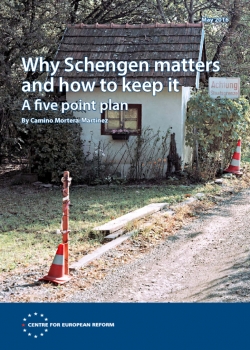
Why Schengen matters and how to keep it: A five point plan
- Schengen, the agreement that abolished national border controls in parts of the EU, may unravel. Unprecedented numbers of asylum seekers and three major terrorist attacks in just over a year have led some member-states to introduce temporary border controls.
- Over the past two months, the flow of migrants and asylum seekers has abated. This is mainly because of an EU-Turkey deal to send back irregular migrants from Greece, and the closure of borders between Balkan countries.
- This improvement may not last long: the EU-Turkey deal is fragile and could crumble for legal, political and practical reasons. And asylum seekers may go back to the more dangerous crossing from Libya to Italy.
- Unless the EU can find a lasting solution to the crisis, there is a risk that national borders will be permanently reinstated across Europe.
- The failure of Schengen would be bad for Europe’s economy. The Schengen area makes seamless travel across Europe easier; and it stimulates labour mobility and trade between Schengen countries.
- The end of Schengen would be a major blow to the prestige and credibility of the European Union, which could easily then be expolited by populist parties.
- To save Schengen, the EU needs to regain control of its external borders. Common European migration and security policies are crucial for this, but they will take years to build. In the meantime, Europe must find ways to manage asylum seekers in an orderly way and keep European citizens safe.
- The roots of the current refugee crisis lie in conflicts outside the EU’s borders. But until those conflicts are settled, the EU needs to do four things to deal with the influx of asylum seekers:
- provide ‘hotspots’ – migrant processing centres in Greece and Italy – with more money, staff and equipment;
- make sure that every Schengen country takes its fair share of refugees; for that, the EU needs to do more to secure Schengen’s external borders;
- offer asylum seekers legal routes to Europe, by resettling them in Europe from countries close to where refugees come from, such as Turkey or Egypt; and
- send as many failed asylum seekers home as possible.
- The porous external border makes it easier for criminals, including jihadists, to enter, travel across and leave Europe. To counter this threat, the EU needs to:
- make better use of existing databases, such as the Schengen Information System, which contains data on wanted and suspicious people, in combination with Eurodac, a database storing the fingerprints of asylum seekers and the Prüm database which contains DNA and fingerprint records.
Copyright is held by the Centre for European Reform. You may not copy, reproduce, republish or circulate in any way the content from this publication except for your own personal and non-commercial use. Any other use requires the prior written permission of the Centre for European Reform.

